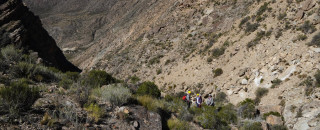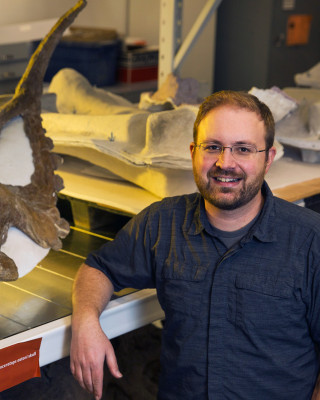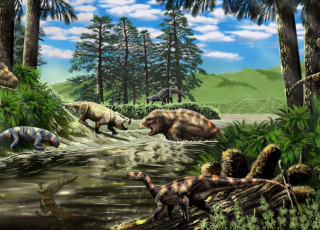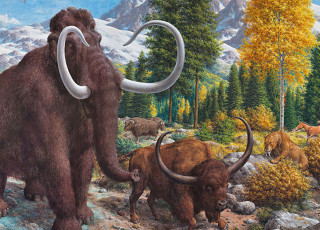How to Tell Geologic Time in the Triassic Period
By Randy Irmis & Cecilia Benavente
All paleontologists face a central question in the field: how old are the fossils I’m collecting, as well as the rocks that preserve them? This might seem like a basic question we should have already answered years ago for most fossil-bearing areas, but the answer is often not so straight-forward. And it’s a quandary our team faced when studying sedimentary rocks and fossils from an area called Santa Clara in northern Mendoza Province, Argentina.
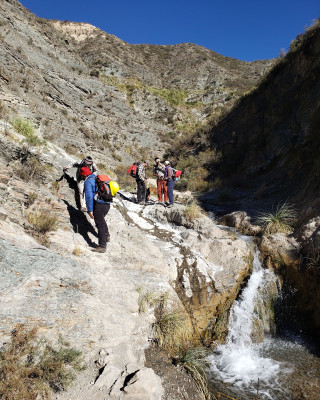
A team of researchers stands in a deep valley alongside a creek in the Santa Clara in northern Mendoza Province, Argentina Photo courtesy of Randall Irmis.
Let’s back up for a second; how do geoscientists go about putting a geologic date on rocks and fossils in the first place? One option, which has been in use for over 200 years, is called relative dating, and uses the fossils themselves. If we know what species of fossils are found in different rock layers in one area, then we can compare the types of fossils we find in a rock layer elsewhere to this first sequence to determine if the rocks in the second area are older, younger, or similar in age. But as the name ‘relative dating’ suggests, this does not allow us to say how old in thousands or millions of years the rocks and fossils are.
To put a number on the age of a rock or fossil, we need to use an absolute dating technique, most commonly radioisotopic dating. One example you might have heard of is radiocarbon (14C) dating, but this only works for organic samples from the last 50,000 years. For much older rocks, like those from the age of dinosaurs, we have to use other techniques like U-Pb dating. This method takes advantage of the fact that when the mineral zircon forms during a volcanic eruption, the crystal structure traps the element uranium, but not lead. However, the radioactive decay of uranium produces lead, and therefore we know that any lead in the zircon crystal is from this radioactive decay. And because we know very precisely the rate of this decay, we can measure the ratio of uranium and lead in the crystal and calculate how many millions of years back in time it crystallized during the eruption. The final piece of the puzzle is that volcanic ash layers containing zircon crystals are often found in between sedimentary rock layers containing fossils, so dating zircons from these ashes can provide accurate age estimates for the adjacent sediments and the fossils they contain.
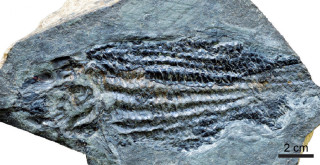
Fossil of a Triassic ray-finned fish from the Santa Clara area. Specimen IANIGLA PV-1242.
In Argentina, the Santa Clara rocks our team was studying were deposited by Triassic lakes, rivers, and streams, and contain a rich fossil record of plants, arthropods, fish, reptiles, and mammal ancestors. We wanted to know exactly when during the Triassic Period (252-201 million years ago) these sediments were deposited. So which dating method did we choose? Initially, our team (as well as previous researchers) conducted relative dating using the microscopic fossil pollen and spores in the sediments, which suggested the rocks were from the Late Triassic Period, sometime between 237 and 209 million years ago. But with such a wide age range of many millions of years, we wanted a more precise answer. So, we then applied U-Pb zircon dating, which to our surprise indicated the rocks and fossils were from between 244-242 million years ago, during the Middle Triassic Period. These results were exciting, because there are very few fossil-bearing Middle Triassic rocks from the Southern Hemisphere that are well-dated, and this time interval is critical for understanding how ecosystems finally recovered from the end-Permian mass extinction at the start of the Triassic Period.
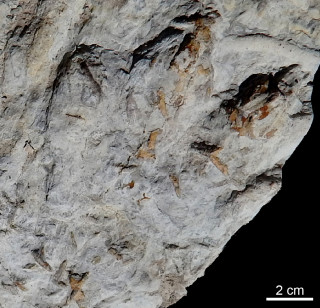
Triassic fossil footprint from the Santa Clara area. Note the four toes pointing towards the upper-right part of the image.
Yet this left us with another question, why did the relative dating using pollen and spores give such a different age compared to the absolute dates? We suspected it might be that the similarities and differences in species during the Triassic might have less to do with geologic time, and more to do with the climate the plants are living in. So, our team statistically compared Triassic pollen and spore data from many different areas across the southern hemisphere to the paleolatitude of the areas during the Triassic Period, as well as their inferred geologic age. Our results demonstrated that when two different areas had similar pollen and spores, it was more likely due to paleolatitude than geologic time. This confirmed our suspicions that climate was playing a role, because we know climate varies greatly across latitude. Therefore, to improve the accuracy of using Triassic pollen and spores for relative dating, we will need more absolute dates, a long-term project for our team.
This research was published in the journal Gondwana Research. The authors of the study are Benavente (Universidad Nacional de Cuyo and IANIGLA, CCT-CONICET, Mendoza), Irmis (NHMU & Department of Geology & Geophysics, University of Utah), Tomas Pedernera and Adriana Mancuso (IANIGLA, CCT-CONICET, Mendoza), and Roland Mundil (Berkeley Geochronology Center). Funding for the study was provided by PICT 2020-2739, the Ann and Gordon Getty Foundation, and University of Utah (RBI). Fieldwork and research were conducted under permits issued by the Dirección de Patrimonio Cultural y Museos, Provincia de Mendoza.
Dr. Randy Irmis is Curator of Paleontology at NHMU, and an associate professor in the Department of Geology & Geophysics, University of Utah. Dr. Cecilia Benavente is a researcher for CONICET and a professor at Universidad Nacional de Cuyo.
